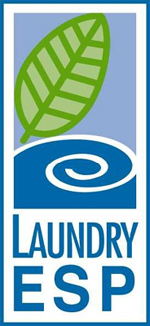Proof Positive of The Industry’s Environmental Impact

Five years in the making (as promised in 1999), LaundryESP, the textile service industry’s voluntary environmental program, has kept its word. We’ve fulfilled our primary goal of expanding industry operators’ continuing commitments to their local environments. We’ve achieved better performance in our use of water, energy, and wash chemicals, and reduced our pollutant discharges. Essentially, the original commitment by UTSA and TRSA to EPA to conduct a voluntary program was the final step in avoiding creation of nationwide laundry wastewater pretreatment limits (also called “effluent guidelines” or “categorical standards”) that would have cost the industry hundreds of millions a year. The associations promised EPA that LaundryESP would improve the industry's environmental protection and resource conservation performance. And we delivered. We unveiled the results to EPA on July 20 (see page 00). Agency staff present represented various EPA divisions, including the one that tried to impose the effluent guideline on the industry. Reflecting six years of industry improvements, the results were more impressive than UTSA, TRSA, or EPA could have envisioned. Here’s how well we did:
Water use: 12.5 percent reduction. Our goal was at least a 10 percent decline in gallons used per pound of textiles processed. The 12.5 percent reduction means that in 2002, we used 5.5 billion gallons less water than our 1997 consumption rate. We saved enough water to supply the annual needs of a city of over 110,000 people.
Energy use: 11.8 percent reduction. Again, we set our sights on at least a 10 percent reduction per pound of textiles processed. Between 1997 and 2002, these energy savings resulted in a greenhouse gas reduction of more than 925 million pounds of carbon dioxide. That is the equivalent of 327,000 cross-country trips by car.
Pollutants discharged: 40 percent reduction. We experienced a 17,500-pound decline in pollutant equivalents discharged to sewers (see insert explanation). We just missed our goal of 20,000, but even the most ardent environmentalists would find it hard to criticize an effort that nearly halved the industry’s wastewater pollutant discharge over a 6-year period.
Environmentally friendly wash chemicals
Though a little more difficult to interpret, data show very clearly that there has been an overall rise in our use of these chemicals as substitutes for less environmentally friendly alternatives.
Some examples include:Peroxide bleaches: 100 percent increase in such bleaches combined into wash formulations, resulting in lower use of chlorine bleaches. The latter is an excellent bleach and disinfectant, and thus an important chemical with respect to the public’s health. Unfortunately, it combines with many other chemicals, both manmade and natural, to create byproducts that can be much more persistent (not biodegradable) and toxic to humans and animals. Because bleaches (hypochlorites, hydrogen peroxides, etc.) are a commodity product, most standard wash chemical suppliers do not directly service this market, and thus LaundryESP did not attempt to collect information on all bleaches used by the industry.
Glycol ethers and terpene solvents, 42 to 302 percent increase, and a 29 and 13 percent decrease, respectively, in aromatic and linear hydrocarbon solvents. Movement away from hydrocarbon stain removers results in lower discharges of toxic and difficult-to-treat pollutants.
Large increase in amphoterics; overall decrease in other major surfactant categories (APE/NPEs, LAEs, and LASs). Standard surfactant categories still dominate, but any increase in the use of amphoterics is environmentally friendly, as this class of chemicals is generally more easily biodegraded and tends to be less harmful to aquatic life.
Enzyme-based detergents: 57 percent increase. These are primarily used for food and healthcare textiles. Their use eliminates the need for less environmentally friendly surfactants and reduces the need for high pH and high-temperature wash formulas.
Some general trends in wash chemical use also result in positive environmental performance:
- Surfactant use shifts save energy by enabling the use of lower temperature wash formulas.
- Increases in the use of lower pH wash formulas save water by reducing rinse volumes.
- Switching to liquid injection systems makes for more efficient use of chemicals (greater accuracy) as well as providing convenience and improving health and safety.
Significance of results
We have been able to voluntarily produce results that go beyond those once forecast as the benefits of the withdrawn industrial laundry effluent guideline. This is an excellent example of how a voluntary program, which fosters flexibility and individualized corporate responsibility, can out produce the government’s traditional command and control approach.
EPA took a chance in 1999 by not promulgating the regulation: the first time the agency had ever made such a choice in the history of the industry-specific categorical standards program. In part, they rested their final decision on our LaundryESP promise and risked a possible lawsuit from environmental groups.
EPA provided guidance as UTSA and TRSA leadership created the program structure and goals. But after their initial involvement, LaundryESP was an industry funded and managed program. UTSA and TRSA led the charge, promoted LaundryESP, recruited participants, and arranged for collection, compilation, and analysis of the data.
Because we were so critical of the data EPA used in its effort to create the proposed guideline, association staff were very careful not to fall prey to the same criticism. Data collection and data quality were deemed a high priority matter at the very start of the program.
UTSA and TRSA developed a detailed data collection plan that called for three different surveys to fill a database with over 2.3 million data fields. The law firm of Collier Shannon Scott, with the assistance of two third-party data collection firms, Environomics and Georgetown Economics, compiled the data so as to maintain complete confidentiality and legal privilege.
Most important, all raw data was subject to a thorough quality check by the consultants as were all the calculations necessary to develop the industry statistics presented to EPA and cited in this article.
Now the agency has our program as a shining example of how industry can fulfill its environmental commitment through voluntary participation that fosters individual corporate responsibility. Our success is significant and groundbreaking and EPA recognizes that.
Thanks to Participants
These results (and positive publicity they will generate over the years to come) are a testimonial to the many participating UTSA and TRSA member companies that decided to make their own commitment to the environment and the future of the textile service industry.
This article would not be complete without thanking the participants, both operators and suppliers, as well as the leadership of both UTSA and TRSA, for making LaundryESP a success.
Some 113 textile service companies with a combined total of more than 700 laundry plants (see insert), accounting for 70 percent of the industry’s production (measured as revenue), currently participate in LaundryESP. In addition, 10 wash chemical companies (see box) have participated, accounting for at least 75 percent of the laundry industry's wash chemical sales.
Only members of UTSA and TRSA could become LaundryESP participants. We estimate that over 1 million textile service customers nationwide are serviced by participating companies.
Each wash chemical supplier has voluntarily provided the program with highly confidential information critical to the fulfillment of our commitment. Many of these companies have developed new products and services specifically designed to advance the goals of LaundryESP. UTSA encourages operators to give these companies priority when considering the purchase of wash aisle services.
The entire industry is indebted to participating members and suppliers. There would be no program without their voluntary dedication of resources to this effort.
Looking to the future
LaundryESP data has already proven its value in our defense against EPA's latest regulatory attack: the proposed shop towel regulation. The program is now just beginning to show its value as a benchmarking, public relations, and marketing tool.
We’ve reached our first milestone, but not the end of our journey. As a team, UTSA and TRSA will continue to monitor the industry’s performance and search for ways for textile service to become even more environmentally friendly.
The program’s immediate focus will be on rolling out the results and generating positive public relations and marketing opportunities for its participants. But LaundryESP’s future will be more than just marketing and I can assure you that it will only be brighter than the program’s first five years.
Look for future IL articles that will discuss many other industry details revealed by LaundryESP and explore the program’s future. I will also present more information at this month's convention.
A full press rollout, targeting trade, mainstream and business media, began in August. A LaundryESP brochure, designed as a laundry marketing and sales tool, will be available to participating companies this month.
Also, the LaundryESP Web site is being redesigned and is scheduled to debut this month. By the end of the year, participating facilities will be able to retrieve their own data from the site and use LaundryESP industry-wide averages, in such areas as water and energy use, to benchmark.
We kept our promise. The textile service industry achieved what EPA could not. Through the leadership of UTSA and TRSA, the industry has made permanent changes that will result in the continuing achievement of significant improvements in environmental performance.
Put simply, the textile service industry is more environmentally friendly than it was five years ago. LaundryESP raised awareness throughout the textile service industry and brought a greater level of environmental responsibility to the foreground.
The program has reinforced our fundamental underlying premise: recycle and reuse. LaundryESP and its commitment to environmental protection and resource conservation is an extension of this concept.
Participating members and their customers have forged new ways of working together on pollution prevention and resource conservation solutions. These strategic partnerships mean that LaundryESP will continue to have an impact on many facilities outside the industry.
Textile service helps customers cost-effectively improve their corporate images and identities, keep their workplaces clean, build employee morale, and more. We also help them achieve their environmental objectives. Because of LaundryESP, this pursuit has a new spirit that will lead to even better results for them. They will thank their textile service companies for years to come.
Textile Service Industry Environmental Performance: 1997-2002
Pollutants discharged: 40% less
Water Use: 12.5% less
Energy Use: 10% less
What’s a "pollutant equivalent"?
According to the LaundryESP results, the industry decreased its “pollutant equivalent” (PE) discharge by 17,500 pounds from 1997 to 1992. This doesn’t mean the discharge load decreased by that amount. The PE stat reflects pollutant toxicity, distorting the actual weight of the substances to serve as a better reading of environmental impact.
PEs discern between the removal of highly toxic pollutants and those of lesser toxicity; calculating them is a way to normalize the varying degrees of a pollutant's toxicity.
EPA has developed a relative toxicity scale and assigned each pollutant a toxicity weighting factor (TWF). For example, mercury, a very toxic metal has a TWF of 500 while chloroform has only a TWF of 0.0021. A "pollutant equivalent" equals the pounds of pollutant multiplied by its TWF.
Thus, if you have equal amounts of two compounds, the compound with the higher TWF will have a greater PE value. In essence, this calculation helps someone examine environmental performance based on its true value to human health and the environment.
Release date: 04/25/2005
Contact: Jerry Martin, V.P. of Sales & Marketing (949) 250-4850 ext 275
By: Jerry Martin, Vice President of Sales & Marketing, Prudential Overall Supply
